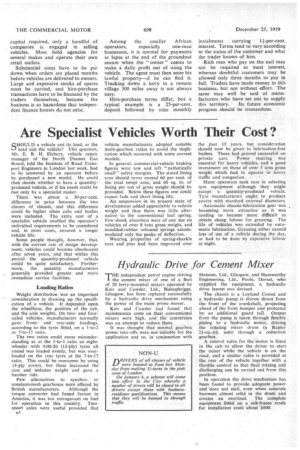Are Specialist Vehicles Worth Their Cost ?
Page 38

If you've noticed an error in this article please click here to report it so we can fix it.
SHOULD a vehicle suit its load, or the load suit the vehicle? This question, Mr. E. B. H. Elsbury, vehicle repair manager of the North Thames Gas Board, told the Institute of Road Transport Engineers in London last week, had to be answered by an operator before he purchased .a new model. He could then decide whether to have a quantityproduced vehicle, or if his needs could be met only by a specialist maker.
There was about a 30-per-cent. difference in price between the two classes of chassis, and this difference could be higher when cabs and bodies were included. The extra cost of a specialist vehicle enabled the operator's individual requirements to be considered and, in most cases, ensured a longer vehicle life.
Some people thought, however, that, with the current rate of design development, vehicles could become obsolescent after seven years, and that within this period the quantity-produced vehicle could be quite satisfactory. Furthermore, the quantity manufacturers generally provided greater and more immediate service facilities.
Loading Ratios
Weight distribution was an important consideration in drawing up the specification of. a vehicle. It depended upon the wheelbase, the position of the cab, and the axle weights. On twoand fouraxled vehicles, manufacturers normally gave frontand rear-axle loadings, according to the tyres fitted, on a 1-to-2 or 7-to-17 ratio.
The two ratios could cause misunderstanding as at the 1-to-2 ratio an eightwheeler with 9.00-20 (12-ply) tyres all round was loaded evenly, but was overloaded on the rear tyres at the 7-to-17 ratio. This could be overcome by using, 14-ply covers, but these increased the Cost and unladen weight• and gave a harsher ride.
Few alternatives to synchroor constant-mesh gearboxes were offered by
British manufacturers. Although the torque converter had found favour in America, it was too extragavant on fuel for operation in this country. Twospeed axles were useful provided that
vehicle manufacturers adopted suitable main-gearbox ratios to avoid the duplication which occurred with some current models.
In general, commercial-vehicle braking figures were low and left "pathetically small" safety margins. The stated lining area should never exceed 60 per cent. of the total swept• area, and 60 sq. in. of lining per ton of gross weight should be provided. Below these figures one could expect fade and short lining life.
Air suspension in its present state of development added appreciably to vehicle weight and thus there was tittle alternative to the conventional leaf spring. Few shock absorbers were of any use on vehicles of over 8 tons gross weight, and moulded-rubber rebound springs accommodated only the peaks of deflection,
Wearing properties of spring-shackle eyes and pins had been improved over the past 15 years, but consideration should now be given to lubrication-free bushes. These had proved successful on private cars. Power steering was essential for heavy vehicles, and a good investment on those of over 5 tons gross weight which had to operate in heavy traffic and congestion.
Many operators took care in selecting tyre equipment although they might accept a quantity-produced vehicle. Tyre manufacturers ought to produce covers with standard external diameters.
Automatic chassis-lubrication gear was becoming more attractive as it was tending to become more• difficult to obtain cheap labour for greasing. The life of vehicles was extended by automatic lubrication. Greasing either caused loss of use of a vehicle during the day, or had to be done by expensive labour at night.
















































































